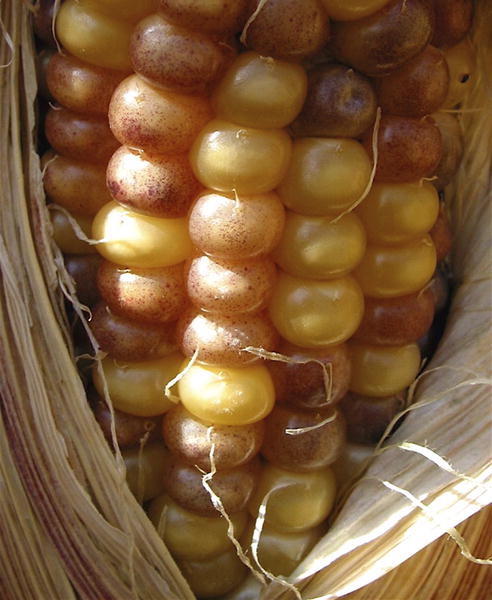|
From rxpgnews.com Genetics
Nearly a century ago, two geneticists described “rogue” pea plants with an unorthodox pattern of inheritance. William Bateson and Caroline Pellew found that crossing inferior rogues with normal plants always produced rogue offspring, suggesting that the rogue appearance was a dominant trait. The real surprise came when rogue progeny were crossed back to normal plants. Following the principles of Mendelian inheritance, these crosses should have produced a mix of normal and rogue plants, but they produced only rogue plants. The phenomenon, later dubbed “paramutation,” allowed the rogues to break the rules by acting “epigenetically”—inducing heritable changes in gene expression without DNA mutations. In one-sided interactions between gene pairs, or alleles, only “paramutagenic” alleles can attenuate, and eventually silence, the expression of “paramutable” alleles.
A new study by Margaret Roth Woodhouse, Michael Freeling, and Damon Lisch sheds light on these somewhat mystifying processes by identifying a gene that keeps both transposons and paramutated color genes silenced in maize, confirming results recently published in Nature. The gene, Mediator of paramutation1 (Mop1), encodes an RNA-processing enzyme called RNA-dependent RNA polymerase 2 (RDR2) that is required to make the small RNAs needed to maintain silencing of a transposon (called MuDR). While Mop1 maintains MuDR silencing, the authors show that a second gene is required to establish heritability of silencing. MuDR can be heritably silenced by a paramutagenic gene called Mu killer (Muk)—an inverted repeat variant of the MuDR transposon. MuDR encodes two genes—mudrA causes excision of the element and, with mudrA, mudrB helps reinsert it. Muk produces hairpin double-stranded RNAs that trigger rapid processing of full-length mudrA into small RNAs, leading to the destruction of mudrA transcripts and the methylation and silencing of MuDR. Muk-induced MuDR silencing begins with mudrA, then spreads to the adjacent mudrB gene. Mutations in Mop1 interfere with both Mutator transposon methylation and paramutation of several maize color genes. Woodhouse et al. found that mop1 is an evolutionary cousin of the RDR2 found in Arabidopsis, where it effects transposon silencing. Maize plants carrying two mutant copies of mop1 failed to produce small RNAs corresponding to mudrA and mudrB—confirming Mop1’s role as an RNA-processing enzyme. To test the mop1 mutant’s effects on Muk-induced MuDR silencing, the researchers bred plants that carried both Muk and MuDR in the presence or absence of a functional copy of the Mop1 gene. Mutant plants showed clear evidence of MuDR silencing, suggesting that Mop1 is not required to initiate silencing. These plants also continued to produce small RNAs specifically associated with the initiation of silencing. Thus, although Mop1 is required to make the small RNAs associated with the maintenance of mudrA and mudrB silencing, it is not required to make the small RNAs associated with the initiation of Muk-induced MuDR silencing. Further, the progeny of these mutant plants carried only inactive MuDR elements, indicating that Mop1 is not required for heritable silencing of MuDR—though there appear to be other factors that are required for this process. Offspring of plants that had both MuDR and Muk but lacked functional nucleosome assembly protein 1 (NAP1, a chromatin-building protein) gave rise to heavily spotted kernels—the sign that heritable MuDR silencing had been disrupted. Yet the loss of NAP1 did not block the initiation of silencing, because these plants had methylated Mutator elements whether or not they expressed NAP1, which suggests that mudrA activity had been lost in both cases. Thus, while losing NAP1 didn’t prevent Muk from initiating MuDR silencing, it did prevent Muk from establishing a stable, heritably silenced state. Altogether, these results show that distinct factors initiate, establish, and maintain MuDR silencing. Muk initiates silencing by targeting mudrA with its hairpin RNAs, leading to the destruction of mudrA transcripts and methylation of the transposon’s terminal inverted repeats. NAP1 is required to establish heritable silencing, likely by changing chromatin into a transcription-unfriendly state. Mop1/RDR2 then maintains silencing by using RNA processing to mediate continued DNA methylation. Given the damage that transposons can cause by inserting themselves into essential genes, it’s not surprising that organisms have evolved enduring mechanisms to keep jumping genes in their place. This study contributes a valuable framework for identifying the factors that regulate the enigmatic epigenetic processes that defend the genome against invasive elements—and helps explain how these changes can persist and be transmitted to the next generation. All rights reserved by www.rxpgnews.com |
